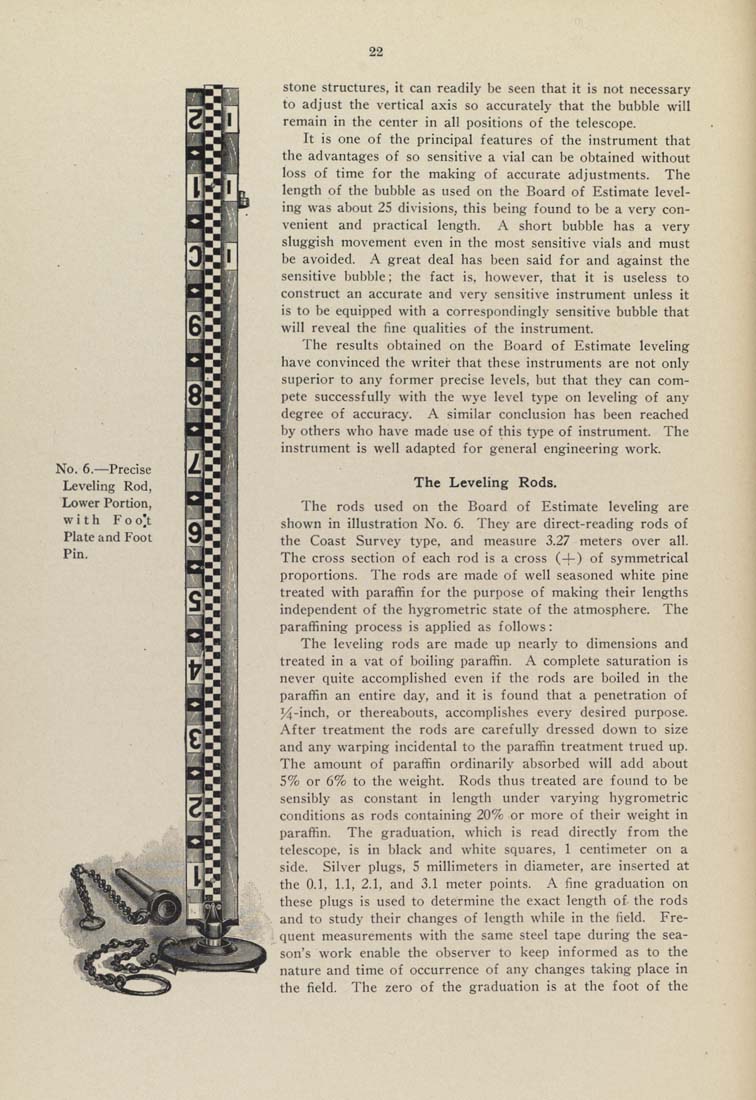No. 6.—Precise
Leveling Rod,
Lower Portion,
with F o o]t
Plate and Foot
Pin.
stone structures, it can readily be seen that it is not necessary
to adjust the vertical axis so accurately that the bubble will
remain in the center in all positions of the telescope.
It is one of the principal features of the instrument that
the advantages of so sensitive a vial can be obtained without
loss of time for the making of accurate adjustments. The
length of the bubble as used on the Board of Estimate level¬
ing was about 25 divisions, this being found to be a very con¬
venient and practical length. A short bubble has a very
sluggish movement even in the most sensitive vials and must
be avoided. A great deal has been said for and against the
sensitive bubble; the fact is, however, that it is useless to
construct an accurate and very sensitive instrument unless it
is to be equipped with a correspondingly sensitive bubble that
will reveal the fine qualities of the instrument.
The results obtained on the Board of Estimate leveling
have convinced the writer that these instruments are not only
superior to any former precise levels, but that they can com¬
pete successfully with the wye level type on leveling of any
degree of accuracy, A similar conclusion has been reached
by others who have made use of this type of instrument. The
instrument is well adapted for general engineering work.
The Leveling Rods.
The rods used on the Board of Estimate leveling are
shown in illustration No. 6. They are direct-reading rods of
the Coast Survey type, and measure 3.27 meters over all.
The cross section of each rod is a cross (-|-) of symmetrical
proportions. The rods are made of well seasoned white pine
treated with paraffin for the purpose of making their lengths
independent of the hygrometric state of the atmosphere. The
paraffining process is applied as follows:
The leveling rods are made up nearly to dimensions and
treated in a vat of boiling paraffin. A complete saturation is
never quite accomplished even if the rods are boiled in the
paraffin an entire day. and it is found that a penetration of
^-inch, or thereabouts, accomplishes every desired purpose.
After treatment the rods are carefully dressed down to size
and any warping incidental to the paraffin treatment trued up.
The amount of paraffin ordinarily absorbed will add about
5% or 6% to the weight. Rods thus treated are found to be
sensibly as constant in length under varying hygrometric
conditions as rods containing 20% or more of their weight in
paraffin. The graduation, which is read directly from the
telescope, is in black and white squares, 1 centimeter on a
side. Silver plugs, 5 millimeters in diameter, are inserted at
the 0.1, 1.1, 2,1, and 3.1 meter points. A fine graduation on
these plugs is used to determine the exact length of the rods
and to study their changes of lengtli while in the field, Fre-
iiuent measurements with the same steel tape during the sea¬
son's work enable the observer to keep informed as to the
nature and time of occurrence of any changes taking place in
the field. The zero of the graduation is at the foot of the
|








